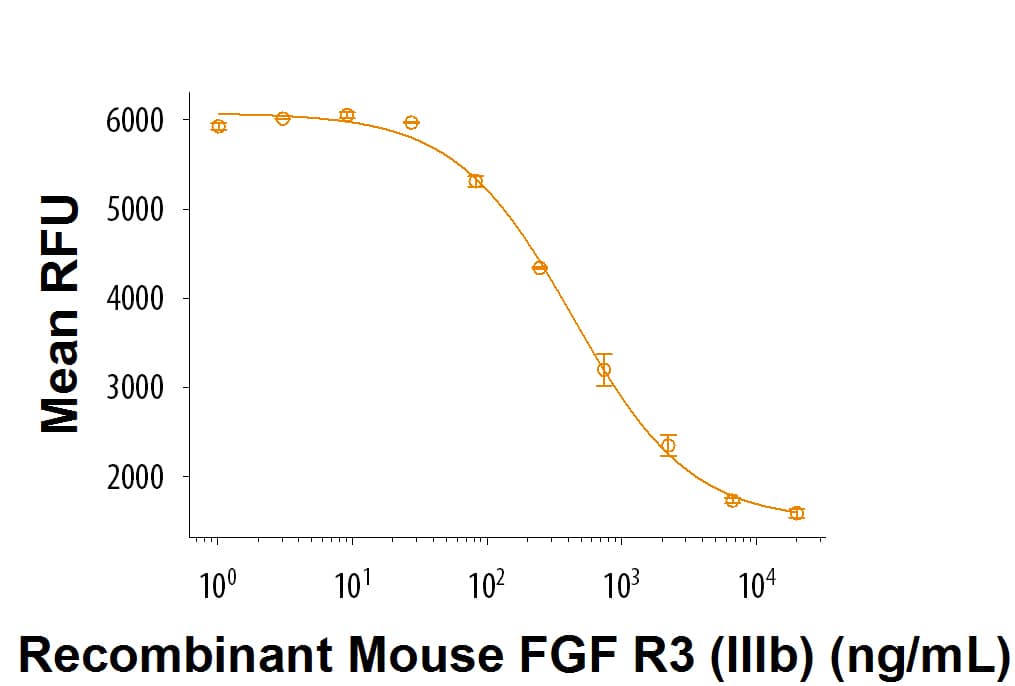Recombinant Human FGFR3 (IIIc) Fc Chimera Protein, CF Summary
Product Specifications
| Human FGF R3 (IIIc) (Glu23-Gly375) Accession # P22607 |
IEGRMD | Human IgG1 (Pro100-Lys330) |
| N-terminus | C-terminus | |
Analysis
Customers also Viewed
Product Datasheets
Carrier Free
CF stands for Carrier Free (CF). We typically add Bovine Serum Albumin (BSA) as a carrier protein to our recombinant proteins. Adding a carrier protein enhances protein stability, increases shelf-life, and allows the recombinant protein to be stored at a more dilute concentration. The carrier free version does not contain BSA.
In general, we advise purchasing the recombinant protein with BSA for use in cell or tissue culture, or as an ELISA standard. In contrast, the carrier free protein is recommended for applications, in which the presence of BSA could interfere.
766-FR
| Formulation | Lyophilized from a 0.2 μm filtered solution in PBS. |
| Reconstitution | Reconstitute at 100 μg/mL in sterile PBS. |
| Shipping | The product is shipped at ambient temperature. Upon receipt, store it immediately at the temperature recommended below. |
| Stability & Storage: | Use a manual defrost freezer and avoid repeated freeze-thaw cycles.
|
Background: FGFR3
Fibroblast growth factors (FGFs) comprise a family of at least eighteen structurally related proteins that are involved in a multitude of physiological and pathological cellular processes, including cell growth, differentiation, angiogenesis, wound healing and tumorgenesis. The biological activities of the FGFs are mediated by a family of type I transmembrane tyrosine kinases which undergo dimerization and autophosphorylation after ligand binding. Four distinct genes encoding closely related FGF receptors, FGF R1-4, are known. All four genes for FGF Rs encode proteins with an N-terminal signal peptide, three immunoglobulin (Ig)-like domains, an acid‑box region containing a run of acidic residues between the IgI and IgII domains, a transmembrane domain and the split tyrosine-kinase domain. Multiple forms of FGF R1‑3 are generated by alternative splicing of the mRNAs. A frequent splicing event involving FGF R1 and 2 results in receptors containing all three Ig domains, referred to as the alpha isoform, or only IgII and IgIII, referred to as the beta isoform. Only the alpha isoform has been identified for FGF R3 and FGF R4. Additional splicing events for FGF R1-3, involving the C-terminal half of the IgIII domain encoded by two mutually exclusive alternative exons, generate FGF receptors with alternative IgIII domains (IIIb and IIIc). A IIIa isoform which is a secreted FGF binding protein containing only the N-terminal half of the IgIII domain plus some intron sequences has also been reported for FGF R1. Mutations in FGF R1-3 have been found in patients with birth defects involving craniosynostosis. The complex patterns of expression of these receptors as well as the specificity of their interactions with the various FGF ligand family members are under investigation.
- Galzie, Z. et al. (1997) Biochem. Cell Biol. 75:669.
- Burke, D. et al. (1998) Trends Biochem. Sci. 23:59.
Citations for Recombinant Human FGFR3 (IIIc) Fc Chimera Protein, CF
R&D Systems personnel manually curate a database that contains references using R&D Systems products. The data collected includes not only links to publications in PubMed, but also provides information about sample types, species, and experimental conditions.
5
Citations: Showing 1 - 5
Filter your results:
Filter by:
-
FGF21-FGFR4 signaling in cardiac myocytes promotes concentric cardiac hypertrophy in mouse models of diabetes
Authors: C Yanucil, D Kentrup, X Li, A Grabner, K Schramm, EC Martinez, J Li, I Campos, B Czaya, K Heitman, D Westbrook, AR Wende, A Sloan, JM Roche, A Fornoni, MS Kapiloff, C Faul
Scientific Reports, 2022-05-05;12(1):7326.
Species: Human
Sample Types: Recombinant Proteins
Applications: Bioassay -
Semi-Automated Cell Panning for Efficient Isolation of FGFR3-Targeting Antibody
Authors: B Min, M Yoo, H Kim, M Cho, DH Nam, Y Yoon
International Journal of Molecular Sciences, 2021-06-09;22(12):.
Species: Human
Sample Types: Recombinant Protein
Applications: Bioassay -
Enhanced Expression of Fibroblast Growth Factor Receptor 3 IIIc Promotes Human Esophageal Carcinoma Cell Proliferation
Authors: Nobuhiro Ueno, Akio Shimizu, Michiyuki Kanai, Yugo Iwaya, Shugo Ueda, Jun Nakayama et al.
Journal of Histochemistry & Cytochemistry
Species: N/A
Sample Types: Antibody
Applications: Bioassay -
2-O Heparan Sulfate Sulfation by Hs2st Is Required for Erk/Mapk Signalling Activation at the Mid-Gestational Mouse Telencephalic Midline.
Authors: Chan W, Howe K, Clegg J, Guimond S, Price D, Turnbull J, Pratt T
PLoS ONE, 2015-06-15;10(6):e0130147.
Species: Mouse
Sample Types: Whole Tissue
Applications: Bioassay -
Targeting the extracellular domain of fibroblast growth factor receptor 3 with human single-chain Fv antibodies inhibits bladder carcinoma cell line proliferation.
Authors: Martinez-Torrecuadrada J, Cifuentes G, Lopez-Serra P, Saenz P, Martinez A, Casal JI
Clin. Cancer Res., 2005-09-01;11(17):6280-90.
Species: Human
Sample Types: Antibody
Applications: Surface Plasmon Resonance
FAQs
No product specific FAQs exist for this product, however you may
View all Proteins and Enzyme FAQsReconstitution Buffers
Reviews for Recombinant Human FGFR3 (IIIc) Fc Chimera Protein, CF
There are currently no reviews for this product. Be the first to review Recombinant Human FGFR3 (IIIc) Fc Chimera Protein, CF and earn rewards!
Have you used Recombinant Human FGFR3 (IIIc) Fc Chimera Protein, CF?
Submit a review and receive an Amazon gift card.
$25/€18/£15/$25CAN/¥75 Yuan/¥2500 Yen for a review with an image
$10/€7/£6/$10 CAD/¥70 Yuan/¥1110 Yen for a review without an image
















